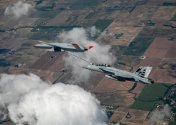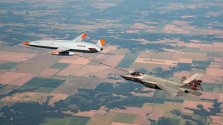You are using an out of date browser. It may not display this or other websites correctly.
You should upgrade or use an alternative browser.
You should upgrade or use an alternative browser.
US Navy MQ-25 Stingray Unmanned Aerial Tanker
- Thread starter Jura The idiot
- Start date
Jura The idiot
General
US Navy’s Drone Tanker Prototype Takes First Flight
inside some incredible statements, considering how Boeing has been handling its 'low-cost, low-risk' KC-46
for those who wouldn't know what I was talking about hahaha: Thursday at 5:29 PM
inside some incredible statements, considering how Boeing has been handling its 'low-cost, low-risk' KC-46
for those who wouldn't know what I was talking about hahaha: Thursday at 5:29 PM
Brumby
Major
Intel Agency Studies MQ-25 For Surveillance Role
Source : Aerospace Daily & Defense Report Oct 2, 2019The U.S. Navy’s MQ-25 is being developed as a carrier-based aerial refueler, but an intelligence agency is showing interest in the unmanned aircraft system for a maritime surveillance role.
The National Geospatial-Intelligence Agency (NGA) has commissioned to study the integration requirements for installing the company’s Multi-Mission Pod (MMP) on the MQ-25.
Boeing developed the MMP using internal funding for the , a submarine hunter derived from the . It is designed to carry multiple payloads, including communication and electronic intelligence receivers.
The NGA-sponsored study will evaluate how to use the MMP to introduce the agency’s “maritime program” on the P-8A and MQ-25 fleets.
The agency on Sept. 30 published a “justification and approval” notice for the study contract awarded to Boeing in May. Such notices are required to justify any contract awarded to a single contractor without a competition.
In this case, the sole source award was justified because the MQ-25 is still early in the development phase, the NGA says, so Boeing is the only company that has access to the design data.
The Navy awarded Boeing an $805 million in August 2018 to deliver four MQ-25 aircraft during the engineering and manufacturing development phase. The overall value of the deal has since risen to $944 million, of which $436 million, or 46.1%, has been obligated, according to the USASpending.gov procurement tracking site.
Last month, Boeing completed the first flight of a company-funded test asset for the MQ-25 program at an airport in Illinois.
The study also suggests the P-8A and MQ-25 fleet could be used to help replace the electronic intelligence capability once performed by the Lockheed EP-3E fleet. The Navy has said that the EP-3E will be replaced by a family of manned and unmanned aircraft, including the P-8A and the MQ-4C unmanned aircraft system.
Jura The idiot
General
hadn't heard ofIntel Agency Studies MQ-25 For Surveillance Role
Source : Aerospace Daily & Defense Report Oct 2, 2019
what's its budget?
LOL Annual budget Classified (at least $4.9 billion, as of 2013)
OK OK
TerraN_EmpirE
Tyrant King
This is a really logical move.
Back in the cold war days, My late Uncle Bob served in USN as a intelligence guy he was posted all over the place Italy and the Philippines I recall stories from. He was both a land sailor and a Sky sailor, in the latter capacity he was a crewman on the EP3 Orion also called Ares and Ares II.
You might recall that long lived from the Hainan island incident which was way after Uncle Bob left the navy.
The P3 had a little carrier capable sibling in the Cold War the S3 Viking. MQ25 was brought onboard to replace the S3. Just as Boeing’s P8 was to replace the P3.
it’s known that Boeing tried to offer the P8 Poseidon as a option to replace the E8 JSTARS the P8 AGS
The Phantom works crew started this pod for the P8 clearly aiming to make an EP8. After the Hormuz RQ4A BAMS D shoot down it makes more sense to try and load such a capability in a VLO unmanned platform for higher risk missions than a non stealthy drone or manned platform.
This however still leaves strike and autonomous wingmen missions lacking from carriers.
Back in the cold war days, My late Uncle Bob served in USN as a intelligence guy he was posted all over the place Italy and the Philippines I recall stories from. He was both a land sailor and a Sky sailor, in the latter capacity he was a crewman on the EP3 Orion also called Ares and Ares II.
You might recall that long lived from the Hainan island incident which was way after Uncle Bob left the navy.
The P3 had a little carrier capable sibling in the Cold War the S3 Viking. MQ25 was brought onboard to replace the S3. Just as Boeing’s P8 was to replace the P3.
it’s known that Boeing tried to offer the P8 Poseidon as a option to replace the E8 JSTARS the P8 AGS
The Phantom works crew started this pod for the P8 clearly aiming to make an EP8. After the Hormuz RQ4A BAMS D shoot down it makes more sense to try and load such a capability in a VLO unmanned platform for higher risk missions than a non stealthy drone or manned platform.
This however still leaves strike and autonomous wingmen missions lacking from carriers.
Last edited:
MQ-25 is really great stuff for the Navy. AAR capability is a significant advantage and shouldn't be limited to recovery-tanking like with the F/A-18 or the Rafale, but en-route refueling during extended-range combat missions. USN and the Marine Nationale are the only one with this refueling aptitude so why not optimize it?
It's also interesting that they're promoting a "scout version". ISTAR capability or what we call Intelligence, Surveillance, Target Acquisition and Reconnaissance, has always been the job of the AWACS and EAW aircrafts AFAIK.
I wish the French Navy buys something similar!
It's also interesting that they're promoting a "scout version". ISTAR capability or what we call Intelligence, Surveillance, Target Acquisition and Reconnaissance, has always been the job of the AWACS and EAW aircrafts AFAIK.
I wish the French Navy buys something similar!
Brumby
Major
This is a really logical move.
Back in the cold war days, My late Uncle Bob served in USN as a intelligence guy he was posted all over the place Italy and the Philippines I recall stories from. He was both a land sailor and a Sky sailor, in the latter capacity he was a crewman on the EP3 Orion also called Ares and Ares II.
You might recall that long lived from the Hainan island incident which was way after Uncle Bob left the navy.
The P3 had a little carrier capable sibling in the Cold War the S3 Viking. MQ25 was brought onboard to replace the S3. Just as Boeing’s P8 was to replace the P3.
it’s known that Boeing tried to offer the P8 Poseidon as a option to replace the E8 JSTARS the P8 AGS
The Phantom works crew started this pod for the P8 clearly aiming to make an EP8. After the Hormuz RQ4A BAMS D shoot down it makes more sense to try and load such a capability in a VLO unmanned platform for higher risk missions than a non stealthy drone or manned platform.
This however still leaves strike and autonomous wingmen missions lacking from carriers.
The ambivalence of the armed services toward VLO unmanned ISR platform is rather inexplicable in my view. It is obvious that the RQ-4s of the world are only able to operate in a permissive environment. There is clearly a capability gap which in theory the RQ-170 should be stepping up but is not as evident by the RQ-4 Triton shoot down. There is no known information on the RQ-180 other than it is expected to act in some teaming manner to the LRSB-21.
I expect to see some accelerated adoption of capabilities with the MQ-25 beyond its initial tanking contribution to ISR.
13 photos in the link provided
A Boeing unmanned MQ-25 aircraft is given operating directions on the flight deck aboard the aircraft carrier USS George H.W. Bush (CVN 77). The MQ-25 will be the world’s first operational, carrier-based unmanned aircraft and is integral to the Air Wing of the Future Family of Systems (AWotF FoS). Its initial operating capability (IOC) as an aerial refueling tanker will extend the range, operational capability and power projection of the carrier air wing (CVW) and carrier strike group (CSG). GHWB is operating in the Atlantic Ocean in support of naval operations to maintain maritime stability and security in order to ensure access, deter aggression and defend U.S., allied and partner interests. (U.S. Navy photos by Mass Communication Specialist 3rd Class Brandon Roberson & Mass Communication Specialist 3rd Class Hillary Becke)


